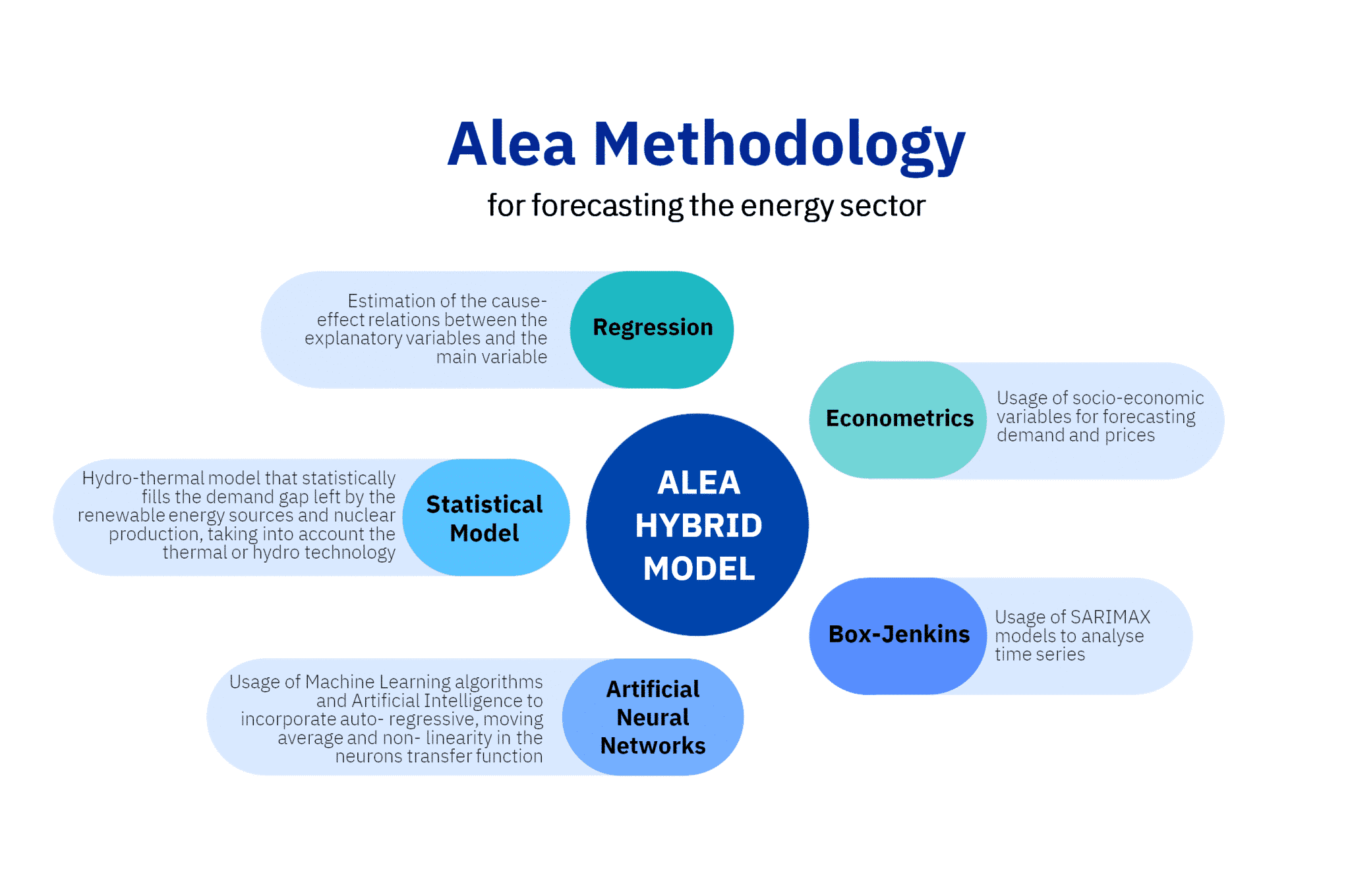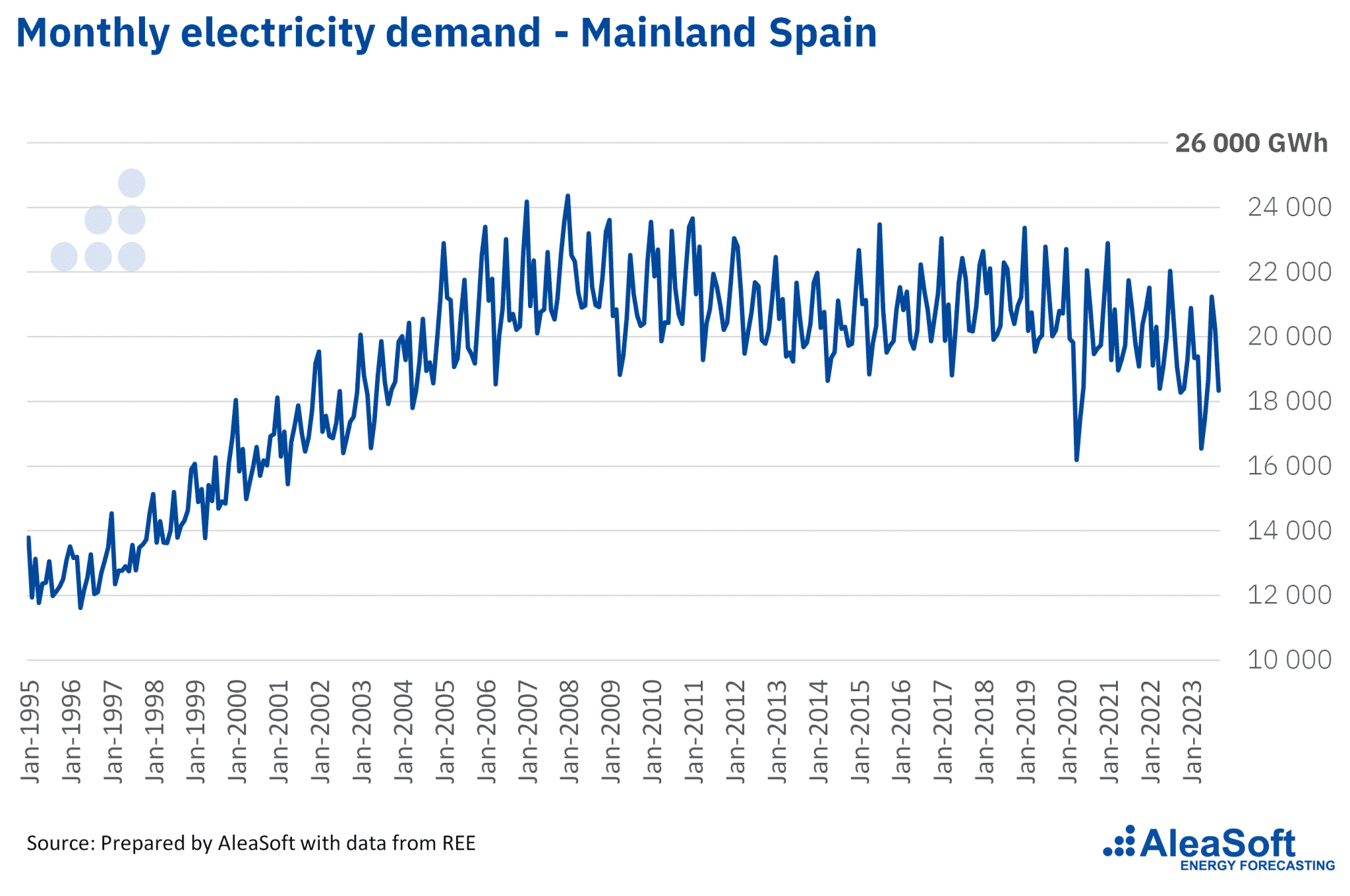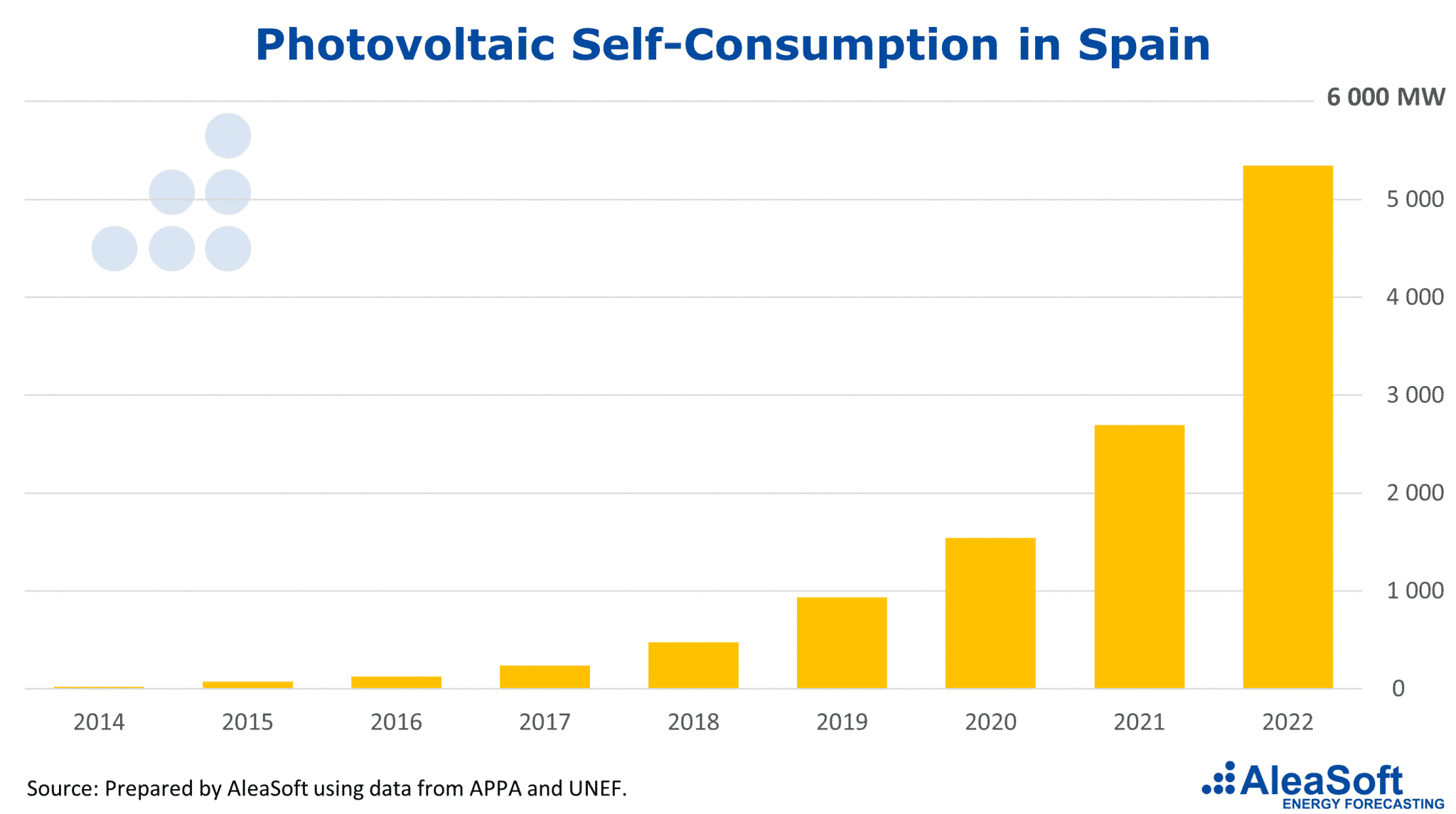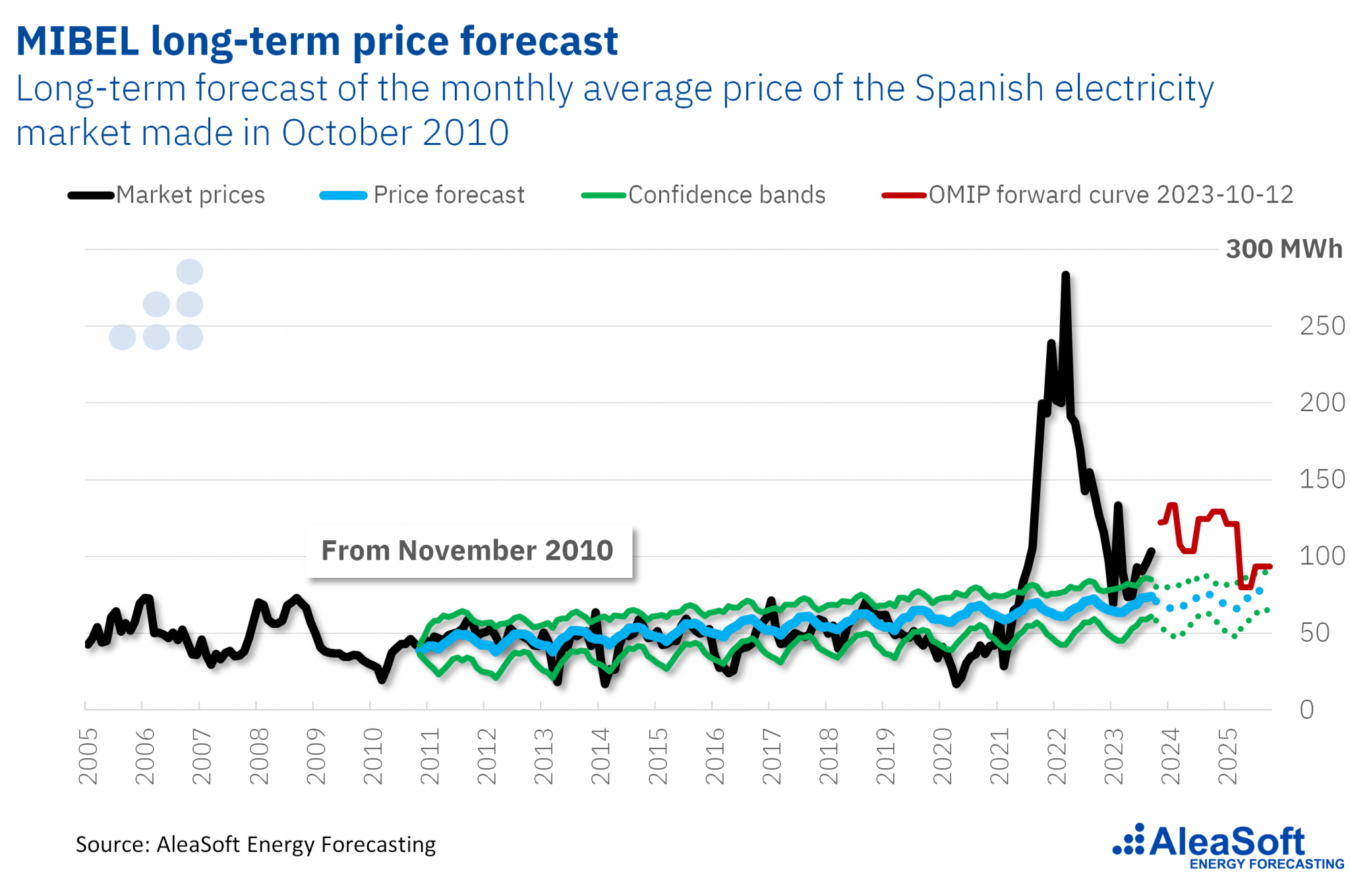AleaSoft Energy Forecasting, October 24, 2023. Interview by Andrea de Lucas from Revista Energética with Antonio Delgado Rigal, PhD in Artificial Intelligence, founder and CEO of AleaSoft Energy Forecasting.

What is the role of technology and data analysis in the development of AleaSoft’s energy price forecasts?
Technology and data analysis are the pillars of the Alea methodology. Our methodology combines recurrent neural networks, which belong to the field of Artificial Intelligence, with the Box-Jenkins methodology and classical statistical techniques. Artificial Intelligence is currently in vogue, but at AleaSoft we have been using it since our inception 24 years ago.
 Source: AleaSoft Energy Forecasting.
Source: AleaSoft Energy Forecasting.
Energy demand is an important component of the energy market. What are the most relevant trends and challenges in energy demand forecasting today?
Some of the key factors to take into account in electricity demand forecasting are weather forecasts and working patterns, i.e. whether it is a weekday, weekend or public holiday.
The hourly profile of demand must also be taken into account, where the impact of self‑consumption is already starting to be seen, and which in the coming years will also be impacted by energy storage, green hydrogen production and flexible demand.

Another factor to be taken into account today is that demand has fallen in 2023. The destruction of industrial demand as a result of the high energy price crisis is one of the causes of this decline. Demand forecasts must therefore take this factor and its future development into account. In addition, the electrification of the economy, the development of electric vehicles, the production of green hydrogen and the demand of Data Centers are elements to be considered in medium and long-term demand forecasts, as they will have an impact on the volume of demand in the coming years.

Brussels is preparing a reform of the European energy market and an agreement is expected before the end of the year. How do you see the proposed changes?
First of all, we think it is very important that it is not a “reform” of the market, because the market will continue to be marginalist, as it has been since its inception, and will continue to operate according to free market principles, without interventionism. This is important for legal certainty and to provide clear price signals to investors.
We welcome the proposed improvements, which aim to accelerate the energy transition, protect consumers from market price volatility and ensure the long-term competitiveness of European industry.
We consider it very important that long-term contracts are promoted and that Contracts for Difference (CfD) co-exist with private Power Purchase Agreements (PPA), a tool which has proved to be very useful in financing many renewable energy projects in recent years and which also helps large electricity consumers to have stability and price visibility in the medium and long term, while at the same time helping them to meet their environmental objectives.
We also consider it very positive that the proposal takes into account the introduction of mechanisms to promote the development of energy storage, given its strategic importance in dealing with situations where renewable energy production is insufficient to meet demand, as well as to reduce curtailments.
Do you think the CfD model is suitable for a reform of the European electricity market?
Yes, any long-term contract is good for buyers and sellers because it helps to reduce market price risk. That is why, as I said, we think it is essential that they co-exist with PPA.
The objective of CfD is to help generation, especially renewable generation, to receive public support in exchange for a stable long-term price with a counterparty that would benefit from this preferential price, for example the electro-intensive industry.
Last June, the government approved an extension to the deadline for obtaining construction permits for renewable energy projects because of the delays that were occurring; how do you think these delays may affect such projects for the remainder of 2023?
The six-month extension to the construction permit deadline was essential; otherwise many projects would have lapsed. Many of the projects that received the Environmental Impact Statement (DIA for its acronym in Spanish) in January were subject to significant changes that made it impossible to meet the construction permit milestone before 25 July, which was the original deadline. This extension will therefore increase the likelihood of more projects coming forward, which is essential for the energy transition.
However, the large number of renewable energy projects currently in the pipeline may again lead to administrative delays and supply problems due to the high demand for components for the construction of the parks, so we believe it is important to make the milestones more flexible so that as many projects as possible are ultimately built.
How do you think the inclusion of renewable energies is affecting energy prices in global markets?
Electricity market prices have fallen during periods of peak renewable generation, especially in those hours when demand is low. At times of high renewable generation and low demand, MWh prices can be close to zero Euros or even below in some European markets.
In addition, the increase in solar photovoltaic energy production, which is concentrated in the daylight hours, has changed the hourly price profile. In the past, the lowest prices were in the early morning, when demand was lower, and the highest prices were during the day and early evening. However, in recent years, with the increase in solar photovoltaic energy capacity and production, the lowest price hours are in the afternoon.

After a record year for self-consumption, how do you think the sector will end this year? Do you think it will come to a standstill?
In 2022, there was a strong increase in self-consumption in Spain, encouraged by high electricity prices. In 2023, electricity prices are not as high as in the previous year, so consumers do not feel as much urgency to self-consume and therefore the pace of installations is slowing down. However, this does not mean that there is a standstill, as some sources indicate that more self-consumption will be installed than in the years before 2022.

What is AleaSoft’s view on the future development of energy prices in the European markets?
In the coming years, if the increase in renewable capacity is not matched by an increase in electricity demand, there could be periods of low prices. There may be some difficult years for electricity generators, especially photovoltaic generators, but it will not be as difficult as it might seem.
The development of energy storage with batteries or green hydrogen, green hydrogen production, electric vehicles and international interconnections will help to offset the increase in renewable production so that prices do not fall steadily.
In addition, demand is smart and if there are low price hours, demand will shift to those hours. An example of this has already been seen in Spain with pumped storage plants, which have historically consumed mainly in the early morning hours when prices are lowest, and in recent years have increased consumption during solar hours, which are currently the hours with the lowest prices.

If there is a situation of continued low prices, this will be an opportunity to attract new demand, for example from Data Centers, which are large consumers of electricity.
In the long-term we expect the market balance in European electricity market prices to be maintained.
What strategies and tools does AleaSoft use to assess and forecast the contribution of renewable energy to the future energy mix?
We use the Alea Methodology, a proprietary scientific methodology created more than 24 years ago, which, as I said, combines Artificial Intelligence, the Box-Jenkins methodology and classical statistical techniques. This methodology, which captures market equilibrium in the past and extrapolates it into the future, is combined with fundamental models that take into account the dynamics of market fundamentals.
For the explanatory variables, such as renewable energies, other electricity generation technologies, demand and commodities, in addition to an average scenario, we run a large number of simulations, from which we obtain price simulations. These price simulations give us confidence bands with different probabilities, which allow us to assess, among other things, the contribution of renewable energies to the energy mix in the future.
What are AleaSoft’s prospects for the future in terms of innovation and development of new tools or services in the field of energy forecasting?
We aim to expand our presence globally and broaden the services we offer to adapt to the new needs of the sector.
We currently forecast most of the European markets and our goal is to cover all the markets on the continent at all horizons.
AleaGreen, AleaSoft‘s division specialized in long-term price curves forecasts needed for the financing of renewable energy projects, has developed long-term forecasts for some markets in America, and we are working to cover the whole continent, also at all horizons. Our mission is to provide our services globally.

We are also developing forecasts for hybrid systems of renewable energies with batteries.
In addition, we act as an intermediary in PPA, bringing together renewable energy developers, off-takers, financial institutions and investment funds, and we collaborate with research centers and educational institutions because we remain committed to R&D, as we have been since the company was founded.
There will be a massive influx of renewable energy storage in the next few years, how will this affect pricing in the electricity market?
It will have a big impact and will be fundamental to achieve an electricity system based on renewable energies. Energy storage will take advantage of the hours of higher renewable energy production, and therefore lower market prices, to charge batteries or produce hydrogen. This will increase the price of those hours. This energy will be fed into the grid during the hours of highest demand and lowest renewable energy presence, i.e. the hours with the highest prices, favoring a drop in prices during these hours. As a result, the price curve will flatten.
